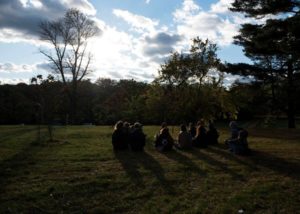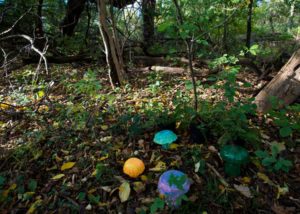“This is what true revolutions are about.
They are about redefining our relationships with one another, to the Earth and to the world….”
Grace Lee Boggs
The Beloved Rhizome
 An idea that has arisen for me out of organizing Mushroom City Art Festival and beginning my Ph.D. in Sustainability Education is an exploration of what I refer to as the Beloved Rhizome. I imagine this space as the interior ground where human and forest networks meet and work together for social and ecological justice. This is a space where people work beside nature to protect both the environment and provide a beautiful, just, and abundant world for all. This is also a site where fungi of the Wood Wide Web work as allies beside humanity to meet the challenges of environmental destruction.
An idea that has arisen for me out of organizing Mushroom City Art Festival and beginning my Ph.D. in Sustainability Education is an exploration of what I refer to as the Beloved Rhizome. I imagine this space as the interior ground where human and forest networks meet and work together for social and ecological justice. This is a space where people work beside nature to protect both the environment and provide a beautiful, just, and abundant world for all. This is also a site where fungi of the Wood Wide Web work as allies beside humanity to meet the challenges of environmental destruction.
This concept is rooted in Dr. Martin Luther King’s vision of the Beloved Community or what writer, bell hooks and Buddhist teacher, Thich Nhat Hanh have referred to as the Community of Love. This vision is further rooted in the work of pioneering scientists such as forest ecologist, Dr. Suzanne Simard and mycologist, Paul Stamets. The Beloved Rhizome acknowledges the interconnectivity and shared agency of life that links human and forest networks together and recognizes that the health of Mother Earth serves the health of the people and vice versa. It’s this shared destiny that serves as a catalyst for social justice and ecological well-being.
To explore the human dimension of this rhizome is to open to Dr. King’s vision of the Beloved Community of people connected together across racial and also political divides in order to overcome the “triple evils” of poverty, racism, and militarism. This process of overcoming these entrenched injustices has as the end goal a community that is returned to health by establishing equal relationships between all individuals including relationships between the oppressor and the oppressed. This was a monumental vision that King held where no one was irredeemable, and this vision was a reflection of Dr. King’s own spiritual work where he embraced a truly radical and heart-centered love for all people.
 The forest side of this rhizome is represented in the Wood Wide Web, an underground fungal network that connects the trees of a forest together in an information and resource-sharing network. Simard’s work has shown that it is through this network where older and more established trees in a forest will share resources with their saplings and trees that are sick or distressed through the Wood Wide Web. It is also through this web where chemicals signals are sent to alert neighboring trees of danger. The equitable distribution of resources through this network offers a model to humanity for overcoming King’s evil of poverty and by extension also racism and militarism by creating an equitable society.
The forest side of this rhizome is represented in the Wood Wide Web, an underground fungal network that connects the trees of a forest together in an information and resource-sharing network. Simard’s work has shown that it is through this network where older and more established trees in a forest will share resources with their saplings and trees that are sick or distressed through the Wood Wide Web. It is also through this web where chemicals signals are sent to alert neighboring trees of danger. The equitable distribution of resources through this network offers a model to humanity for overcoming King’s evil of poverty and by extension also racism and militarism by creating an equitable society.
Additionally, the Wood Wide Web is both a literal and symbolic representation of the rhizome that possesses seemingly infinite design solutions. The work of Stamets, in particular, has shed light on using mushrooms to eat oil, purify water, and address colony collapse disorder in addition to possessing a wide array of other profound biomimetic design solutions.
In this time of the Anthropocene, where humanity is the primary driver behind climate change, embracing our shared connection and destiny with the natural world is key to planetary survival. Acknowledging the relationships and invisible web of connection that knit people together in family and community is integral for the health and mutual well-being of people and planet. Similarly, the Wood Wide Web supports an equal distribution of resource sharing. The health of the collective and the health of the individual are both supported through this forest network, and the Beloved Rhizome arises as a space for social networks to embrace forest networks in our shared future in working for a more fair, just, and regenerative world for all beings.
